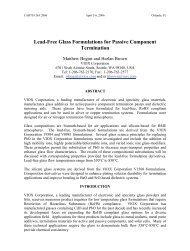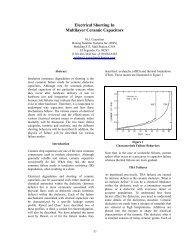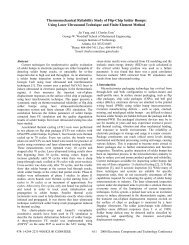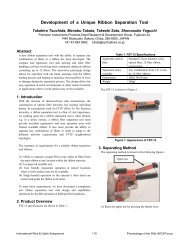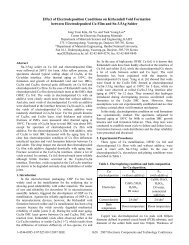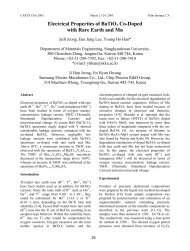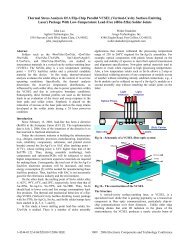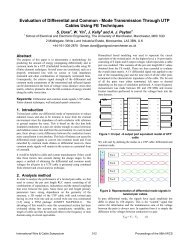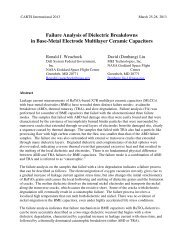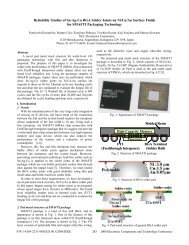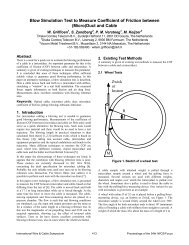Thermoplastic Polyurethane Applications in the Wire and Cable ...
Thermoplastic Polyurethane Applications in the Wire and Cable ...
Thermoplastic Polyurethane Applications in the Wire and Cable ...
You also want an ePaper? Increase the reach of your titles
YUMPU automatically turns print PDFs into web optimized ePapers that Google loves.
<strong>Thermoplastic</strong> <strong>Polyurethane</strong> <strong>Applications</strong> <strong>in</strong> <strong>the</strong> <strong>Wire</strong> <strong>and</strong> <strong>Cable</strong> IndustryRabeh Elleithy 1 <strong>and</strong> Arm<strong>and</strong>o SardanopoliElastollan ® TPU, BASF Corporation, Wy<strong>and</strong>otte, MI 48192Introduction<strong>Thermoplastic</strong> polyurethane elastomer (TPU) hasbeen used as a jacket<strong>in</strong>g material for different types ofcables. For example, TPU is used as a jacket<strong>in</strong>g materialfor above ground m<strong>in</strong><strong>in</strong>g cables due to its high abrasionresistance. TPU also has excellent low temperatureflexibility, high tear resistance, <strong>and</strong> good <strong>in</strong>sulationproperties. For <strong>the</strong>se reasons <strong>and</strong> o<strong>the</strong>rs that will bediscussed <strong>in</strong> this paper, TPU found its use as a secondary<strong>in</strong>sulat<strong>in</strong>g material as well as a primary <strong>in</strong>sulat<strong>in</strong>gmaterial <strong>in</strong> special cases.MaterialTPU belongs to <strong>the</strong> family of <strong>the</strong>rmoplastic elastomer(TPE). TPE is a two-phase system that could be generallydivided <strong>in</strong>to two categories: [1] block copolymers <strong>and</strong> [2]elastomer blends. Block copolymers TPE, example ofwhich is TPU, consist of blocks of hard segments <strong>and</strong>blocks of soft segments with<strong>in</strong> <strong>the</strong> same molecule. On <strong>the</strong>o<strong>the</strong>r h<strong>and</strong>, elastomer blends TPE, example of which is<strong>the</strong>rmoplastic vulcanizate TPV, are generally aheterogeneous blend of soft rubbery material <strong>in</strong> a hard<strong>the</strong>rmoplastic matrix. Figure 1-a shows a schematicpresentation of TPU as an example of block copolymersTPE. Figure 1-b represents TPV as an illustration ofelastomer blends TPE.(a)when <strong>the</strong> isocyanate reacts with <strong>the</strong> long cha<strong>in</strong> polyol, asoft segment is formed. The hard segments <strong>in</strong>teracttoge<strong>the</strong>r to form local crystals that act as physical crossl<strong>in</strong>ks.Whereas, <strong>the</strong> long soft segments are tied toge<strong>the</strong>rwith <strong>the</strong> physical cross-l<strong>in</strong>ks which give TPU itselastomeric behavior (2) .The material that will be discussed here is Polye<strong>the</strong>rTPU, namely Elastollan ® produced by BASF Corporation.Several Elastollan ® products that have different hardness<strong>and</strong> flame retardancy will be compared <strong>and</strong> contrasted toeach o<strong>the</strong>r. Table I lists <strong>the</strong> Elastollan® TPU, <strong>the</strong>irhardness, <strong>and</strong> <strong>the</strong>ir flame retardancy rat<strong>in</strong>gs. The flameretardancy rat<strong>in</strong>gs are found from tests performed <strong>in</strong> ourlabs based on UL94 test<strong>in</strong>g procedure at a specificthickness. Similarly, <strong>the</strong> hardness, shore A or D, is basedon our lab results by follow<strong>in</strong>g ASTM D2240 as ourguidel<strong>in</strong>e.Table I: List of <strong>the</strong> discussed materials <strong>and</strong> <strong>the</strong>irnomenclatures.# Elastollan ® Hardness UL9475W 1175A10W 75A V0-V285A 1185A10 85A HB85W 1185A10W 83A V285F 1185A10F 87A V085FHF 1185A10FHF 89A V054D 1154D 53D --54FHF 1154D-FHF 58D V2-V0T P E - U, E , AFigure 1: Schematic presentations of (a) block copolymer<strong>and</strong> (b) elastomeric blend of TPE.TPU is formed by <strong>the</strong> step polyaddition of isocyanatewith a diol <strong>and</strong> long cha<strong>in</strong> polyol. Depend<strong>in</strong>g on <strong>the</strong> longcha<strong>in</strong> polyol type, TPU could be divided <strong>in</strong>to Polye<strong>the</strong>rTPU or polyester TPU (1) . In this paper we will befocus<strong>in</strong>g on <strong>the</strong> Polye<strong>the</strong>r TPU. When <strong>the</strong> isocyanatereacts with <strong>the</strong> diol, a hard segment is formed. Similarly,(b)The W <strong>in</strong>dicates a plasticized material; F is a flameretardant material; <strong>and</strong> FHF is a halogen free flameretardant material.PropertiesThe selection criteria of cable jacket<strong>in</strong>g could bedivided <strong>in</strong>to: [1] mechanical, [2] environmental/chemical,[3] <strong>the</strong>rmal, [4] electrical, <strong>and</strong> [5] regulations necessities(3) . Here, we will discuss briefly <strong>the</strong> properties of <strong>the</strong>Elastollan ® TPUs listed <strong>in</strong> Table I as related to <strong>the</strong>seselection criteria. We will correlate between <strong>the</strong>seproperties & <strong>the</strong> appropriate applications <strong>in</strong> <strong>the</strong> wire <strong>and</strong>cable (W&C) <strong>in</strong>dustry.1 Correspond<strong>in</strong>g authorInternational <strong>Wire</strong> & <strong>Cable</strong> Symposium 524 Proceed<strong>in</strong>gs of <strong>the</strong> 54th IWCS/Focus
Mechanical PropertiesThe most strik<strong>in</strong>g mechanical property of TPU is itsexcellent abrasion resistance. Table II compares <strong>the</strong>abrasion resistance of TPU to o<strong>the</strong>r typical plastics. Thedata of Table II was obta<strong>in</strong>ed by perform<strong>in</strong>g Taberabrasion us<strong>in</strong>g CS17 wheel, 1000 g weight, <strong>and</strong> 5000revolutions (4) .Table II: Taber abrasion resistance of selected plastics.Plastic materialTPU 0.4 – 3.2HDPE 29PTFE (Teflon) 42Nylon 6/6 58Plasticized PVC 187Butyl Rubber 205Neoprene 280Weight loss, mgThis high abrasion resistance promoted <strong>the</strong> use of TPU <strong>in</strong>applications that require excellent scratch or scraperesistance, e.g. above ground m<strong>in</strong><strong>in</strong>g cables.Elastollan ® TPU also has high elongation at break<strong>and</strong> excellent tear resistance as shown <strong>in</strong> Table III (2) .Table III: Elongation at break <strong>and</strong> tear resistance ofdifferent Elastollan ® TPUs.75W 85W 85F 85FHF 54FHFchange <strong>in</strong> mechanical properties is a factor of <strong>the</strong>exposure temperature <strong>and</strong> <strong>the</strong> duration. For example, itwill take about 30 months at 100°C to reduce <strong>the</strong>elongation at break of 85FHF from 500% to 300%. On<strong>the</strong> o<strong>the</strong>r h<strong>and</strong>, it will take about 6 months at 120°C toreduce <strong>the</strong> elongation at break of 85FHF from 500% to300% (2)In <strong>the</strong> same token, when TPU is immersed <strong>in</strong> waterfor various periods of time at different temperatures, itsmechanical properties would change. For example,immers<strong>in</strong>g 85FHF <strong>in</strong> water at 70°C for 41 months wouldreduce its elongation at break from 500% to 300%. On<strong>the</strong> o<strong>the</strong>r h<strong>and</strong>, it will take about 10 months at 80°C toreduce <strong>the</strong> elongation at break of 85FHF from 500% to300% (2) .In contrast, when 85A was immersed at 100°C for 14Days <strong>in</strong> ASTM oil-1, 2, <strong>and</strong> 3, its elongation at break <strong>and</strong>maximum strength <strong>in</strong>creased (2) .Thermo-mechanical PropertiesA schematic presentation of <strong>the</strong> <strong>the</strong>rmo-mechanicalbehavior of 85A <strong>and</strong> 54D TPU (2) materials is illustrated <strong>in</strong>Figure 2. The curves of Figure 2 show <strong>the</strong> change of <strong>the</strong>material modulus as a function of temperature as obta<strong>in</strong>edby Dynamic Mechanical Analysis (DMA). At very lowtemperatures, both 85A <strong>and</strong> 54D have similar modulus.However as <strong>the</strong> temperature <strong>in</strong>creases, 85A shows moreflexibility (lower modulus) than 54D. This is to say thatsoft TPU, like 85A, will be a more suitable jacket<strong>in</strong>gmaterial when low temperature TPU flexibility is <strong>the</strong>ma<strong>in</strong> concern. Whereas, hard TPU, e.g. 54D, will be abetter choice for a jacket<strong>in</strong>g material if high temperatureperformance is required.Elong @Brk, %685 595 505 500 350ModulusTearresistanceKN/m57 88 96 95 11085A54DThe elongation at break was measured us<strong>in</strong>g ASTM D412as our guidel<strong>in</strong>e, <strong>and</strong> <strong>the</strong> tear strength was performed byfollow<strong>in</strong>g <strong>the</strong> guid<strong>in</strong>g pr<strong>in</strong>ciples of ASTM D624 die C.As <strong>the</strong> TPU material gets harder, its elongation at breakdecreased <strong>and</strong> its tear strength <strong>in</strong>creased as seen fromTable III. Even <strong>the</strong> lowest values shown <strong>in</strong> Table III arestill better than typical <strong>in</strong>sulat<strong>in</strong>g materials, e.g. PVC haselongation at break of 330% <strong>and</strong> tear strength of 18 KN/m(1) .Environmental EffectsWhen TPU material was exposed to long-term ovenag<strong>in</strong>g at different temperatures for different durations oftime, <strong>the</strong>ir mechanical properties were changed. The0.0C25CTemperatureFigure 2: DMA behavior of 85A <strong>and</strong> 54DA comparison between <strong>the</strong> low temperaturecharacteristics <strong>and</strong> high temperature performance ofdifferent TPUs is shown <strong>in</strong> Figure 3 (2) . The glasstransition temperature, T g , expresses <strong>the</strong> low temperaturecharacteristic. T g is <strong>the</strong> temperature at which <strong>the</strong> polymertransfers from <strong>the</strong> glassy state to <strong>the</strong> rubbery state.International <strong>Wire</strong> & <strong>Cable</strong> Symposium 525 Proceed<strong>in</strong>gs of <strong>the</strong> 54th IWCS/Focus
Figure 3: Comparison of T g <strong>and</strong> Vicat temperatures ofdifferent Elastollan ® TPUs.As T g decreases, TPU will stay more flexible at lowertemperatures. Low temperature flexibility of TPU comeswith excellent impact resistance at sub ambienttemperatures. For example, when perform<strong>in</strong>g Charpyimpact on un-notched samples per ISO 179, 75W, 85W,85FHF do not break even at –50°C (2) test<strong>in</strong>g temperature.The Vicat soften<strong>in</strong>g temperature, ASTM D1525,exemplifies <strong>the</strong> high temperature performance.Generally, harder TPU will have higher Vicat po<strong>in</strong>t, <strong>and</strong>will perform better at high temperature as compared tosofter TPU.Electrical PropertiesGenerally speak<strong>in</strong>g, <strong>the</strong> electrical properties of TPUsuggest its usage for energy cables up to 1000V (5) . Anexception to that would be cables for high frequencytransmission, e.g. antenna cables. Table IV lists someelectrical properties of TPUs material based lab tests atroom temperature by follow<strong>in</strong>g various IEC st<strong>and</strong>ards.As seen from Table IV, as <strong>the</strong> material gets harder, its<strong>in</strong>sulation properties improve.Table IV: List of some electrical properties of 85A <strong>and</strong>54D.Vol.Resis.,Ω.cmSurf.Resis.,ΩDielec.Strength,KV/mm85A 10 12 10 15 32 0.1054D 10 14 10 15 36 0.06Diss.Factor @1MHzTemperature <strong>and</strong> environment also affect <strong>the</strong> <strong>in</strong>sulationproperties (6) . For example, as <strong>the</strong> temperature <strong>in</strong>creases,<strong>the</strong> volume resistivity decreases. Similarly, <strong>the</strong> volumeresistivity measured after immers<strong>in</strong>g <strong>the</strong> material <strong>in</strong> waterfor different time duration is lower than <strong>the</strong> orig<strong>in</strong>al value.In contrast, as <strong>the</strong> temperature <strong>in</strong>creases <strong>the</strong> dielectricstrength <strong>in</strong>creases to a maximum at about 60°C <strong>the</strong>n itstarts to decrease.RegulationsUnder specific temperatures <strong>and</strong> o<strong>the</strong>r favorableconditions, various polymers would burn. There aredifferent regulations that identify <strong>the</strong> characteristics <strong>and</strong>smoke release of polymers dur<strong>in</strong>g burn<strong>in</strong>g. Refer toTable I for one burn<strong>in</strong>g characteristic of some TPUs.Table V summarizes <strong>the</strong> smoke release characteristics<strong>and</strong> <strong>the</strong> limit<strong>in</strong>g Oxygen <strong>in</strong>dex, LOI, of 85A <strong>and</strong>85FHF (6) . The smoke characteristics are measuredaccord<strong>in</strong>g to <strong>the</strong> French st<strong>and</strong>ards NF X10-702<strong>and</strong> NF 16-101. Whereas, <strong>the</strong> LOI is measured accord<strong>in</strong>g to ISO4589-1 /-2.Table V: List of some properties of 85A <strong>and</strong> 85FHF.D m VOF4 Class LOI85A 97 190 F1 23 Vol-%85FHF 253 512 F2 24 Vol-%Where D m is <strong>the</strong> maximum optical density, VOF4 is <strong>the</strong>speed of smoke development <strong>in</strong> <strong>the</strong> first four m<strong>in</strong>utes, <strong>and</strong><strong>the</strong> class is a classification of <strong>the</strong> material based on itssmoke <strong>in</strong>dex.Typical <strong>Applications</strong>Ow<strong>in</strong>g to <strong>the</strong> previously discussed properties, <strong>and</strong>o<strong>the</strong>rs, TPU found its notable application as a unique<strong>in</strong>sulator <strong>in</strong> <strong>the</strong> W&C <strong>in</strong>dustry. Some of <strong>the</strong>seapplications along with <strong>the</strong> relevant TPU properties aresummarized <strong>in</strong> Table VI (6) .Table VI: Typical cable applications that use TPU as ajacket<strong>in</strong>g or <strong>in</strong>sulat<strong>in</strong>g material.<strong>Cable</strong> App.IndustrialDragM<strong>in</strong><strong>in</strong>gControlOffshoreABSFlat <strong>Cable</strong>SummaryPropertiesSputter<strong>in</strong>g resistance & ToughnessFlexibility & Fatigue resistanceCut & Abrasion resistanceInsulation prop. & Low-temp flex.Hydrolysis & Microbial resistanceReliability & Tear resistanceCrease resistance & FlexibilityBecause of its unique properties, TPU Elastollan ® isconsidered <strong>the</strong> ideal <strong>in</strong>sulat<strong>in</strong>g / sheath<strong>in</strong>g material forspecial cables. Some of <strong>the</strong>se unique properties areexcellent abrasion / wear resistance, flexibility, lowtemperatureflexibility, excellent tear & impact resistance,resistance to Ozone, <strong>and</strong> resistance to hydrolysis.International <strong>Wire</strong> & <strong>Cable</strong> Symposium 526 Proceed<strong>in</strong>gs of <strong>the</strong> 54th IWCS/Focus
Consequently, TPU is used <strong>in</strong> drag-cables, offshorecables, control bundles, power cables, coiled cables,seismic streamer sleeves, <strong>and</strong> o<strong>the</strong>r cable applications.The data presented here are based on resultsperformed <strong>in</strong> <strong>the</strong> lab. The f<strong>in</strong>al performance of <strong>the</strong> cableshould be checked <strong>and</strong> evaluated as it depends on factorso<strong>the</strong>r than <strong>the</strong> <strong>in</strong>sulated material.References(1) DeGross, J. L., International wire & cablesymposium proceed<strong>in</strong>gs, P. 831, November.1999.(2) Elastollan® technical bullet<strong>in</strong>, BASFCorporation.(3) Electrical <strong>Wire</strong> H<strong>and</strong>book, <strong>the</strong> wire association<strong>in</strong>ternational.(4) H<strong>and</strong>book of <strong>the</strong>rmoplastic elastomers, Littoneducational publish<strong>in</strong>g, 1979.(5) Bertels, TPU for high performance cables,Kunststoffe, Feb. 2001.(6) Elastollan® cable sheath<strong>in</strong>g, Elastogran, BASFpublication.BiographyRabeh Elleithy- Author of 25+ papers <strong>in</strong> <strong>the</strong> field of polymerapplications <strong>and</strong> characterization.- Has more than 16 years ofexperience <strong>in</strong> <strong>the</strong> polymerfield.- Holds a Ph.D. <strong>in</strong> PolymersScience <strong>and</strong> Eng<strong>in</strong>eer<strong>in</strong>g.- Currently works at BASFCorporation <strong>in</strong> <strong>the</strong>Technical ServiceDepartment of <strong>the</strong> TPUbus<strong>in</strong>ess.Arm<strong>and</strong>o Sardanopoli- Over 35 years ofexperience <strong>in</strong> <strong>the</strong> TPU<strong>in</strong>dustry <strong>in</strong> <strong>the</strong> area ofproduct <strong>and</strong> applicationsdevelopment.- Currently works as <strong>the</strong>technical manager of <strong>the</strong> TPU bus<strong>in</strong>ess at BASFCorporation.International <strong>Wire</strong> & <strong>Cable</strong> Symposium 527 Proceed<strong>in</strong>gs of <strong>the</strong> 54th IWCS/Focus



